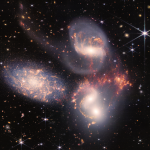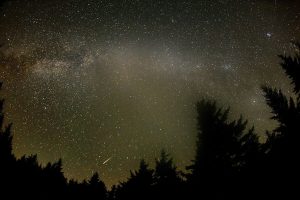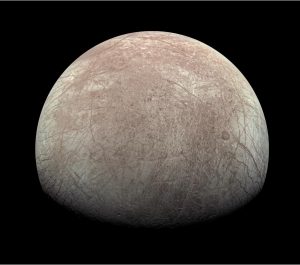
Meeting in the shadow of asteroids: Yoshida Fumi has been awarded the DaBoll Award for her leadership in occultation observations
Ground Observation Lead for the DESTINY+ mission, Yoshida Fumi has been awarded the Homer F. DaBoll Award for leading a joint collaboration between researchers and amateur astronomers to observe the stellar occultations of asteroid Phaethon.
Despite both radar and optical observations from Earth, asteroid Phaethon was proving elusive.
“Phaethon’s orbit is special compared to other near-Earth asteroids,” explains Yoshida Fumi at the Planetary Exploration Research Center, Chiba Institute of Technology, and the University of Occupational and Environmental Heath, Japan. “There’s never a chance to observe Phaethon from Earth with a solar phase angle of zero degrees.”

The solar phase angle is the angle between the Sun, the observed object (in this case, asteroid Phaethon), and the observer (often on the Earth). A smaller phase angle indicates that a greater portion of the sunlit side of the observed object can be seen. At a phase angle of zero, the visible side of the object is entirely illuminated to give its full brightness. In the case of the Moon, changes in the solar phase angle result in the Moon’s “phases”, and a phase angle of zero corresponds to a full Moon.
For asteroids such as Phaethon, observations of the full brightness at a zero phase angle allow the reflectance or “albedo” of the asteroid to be estimated. This is particularly important for Phaethon, as the asteroid is the target for the up-coming JAXA DESTINY+ mission, which is aiming to fly-by Phaethon and image the asteroid at close quarters. For the best results, the cameras onboard the spacecraft need to be designed for the asteroid’s expected brightness during the fly-by, making the amount of reflected light a key value.

Faced with the impossibility of measuring the asteroid’s full brightness at zero phase angle, Yoshida considered another solution. The reflectance of an asteroid is calculated from the asteroid’s brightness[1] and its size. The asteroid size is frequently estimated based on a thermal model, which also depends on the impossible-to-measure brightness. Without that zero phase angle value, the error in the brightness would therefore be multiplied, jeopardising the validity of the resulting reflectance value. However, there was a way to measure the asteroid size directly from observations. If the size could be measured accurately, the error on the brightness would be less important and a sufficiently accurate reflectance could be calculated.
What Yoshida wanted to do was to observe the tiny shadow of Phaethon on the Earth as the asteroid passed in front of a star. This mini eclipse is known as an occultation. The longer an occultation lasts, the larger the celestial body that is blocking the starlight. But this is a tricky measurement.
On October 3, 2021, Phaethon was due to occult a star near the boundary of the constellations of Auriga and Perseus. The shadow was expected to last no more than 0.6 seconds. Until recently, such a short event would not even be considered for an observation. But the landscape has now changed.
”In the past, the accuracy in determining the orbits of asteroids was not so good,” explains Yoshida. “Even if an occultation event was predicted, there was a large error in the occultation zone, and there were times when the eclipse did not occur as predicted.”
New all-sky surveys to pin down the orbits of small asteroids, and a significant improvement in the positional accuracy of stars from ESA’s Gaia mission have allowed occultation events to be far better predicted. An additional improvement is one of technology, allowing cameras to take many photographs in extremely rapid succession.

“The recently available CMOS cameras are capable of taking images at high speed, making it possible to capture more than 100 frames per second. In other words, a 0.6 second event is well within range,” continues Yoshida. “The CMOS camera, the orbital accuracy of asteroids and the positional accuracy of stars have all been improved, making it possible to observe occultation events even with a very short time duration.”

But a technically possible observation did not mean an easy one. Even with the occultation event tightly determined, the shadow of the tiny asteroid will only fall over a small part of the Earth’s surface. To observe the occultation, you therefore need to be in the path of the shadow, and there is no guarantee that this will cover an observatory. Moreover, asteroids are not regular shapes and their shadows are similarly complex. The duration of the occultation will therefore depend on whether you are positioned in a wide or narrow part of the shadow, resulting in different measured values for the size depending on observation location. This makes it necessary for the shadow to be observed from several different locations to assess its extent, making it still harder to use professional facilities. The time for the occultation is also incredibly short. While a solar eclipse, which is a lunar occultation of the Sun, can last an hour, an asteroid of Phaethon’s size covering the light from a distant star will do so for less than a second. Finally, this drop in light within the asteroid shadow is tiny, as only one star is being obscured. So not only is location key, but the observation itself must be precise and well planned.
Yoshida knew of one group that could handle this large number of challenges. She reached out not to the observatories, but to the amateur astronomy community. Armed with telescopes that could easily be moved into position, the astronomers were able to spread out across the expected shadow region and focus on the star that Phaethon was anticipated to cross.
“Seventy two people participated in the observation from thirty six different sites,” says Yoshida. “About one fifth of the observation sites were covered by professional researchers, but the rest were covered by amateur astronomers. The Phaethon occultation was ultimately captured at 18 of these locations!”

For the October 3 occultation of Phaethon, the observations were mainly from Japan with a few from Korea. This event was particularly successful, and Yoshida also approached NASA, the Southwest Research Institute in Texas (SwRI), and the International Occultation Timing Association (IOTA) on behalf of the DESTINY+ team to observe occultation events by Phaethon between 2019 and 2021 with both amateur-led and researcher-led groups.
“I hope my urging of everyone to take on this challenge to observe stellar eclipses by small asteroids like Phaethon may have ignited the spirit of challenge in occultation observers around the world!” says Yoshida.
The result of the observation efforts of both researchers and amateur astronomers was that the size of Phaethon was established to be about 5km in diameter.
The value in establishing the cooperative relationship between professional researchers and amateur observers was recognised when Yoshida was awarded the IOTA’s Homer F. DaBoll Award this year. Named after the founding officer of the IOTA , the DaBoll Award recognises significant contributions to occultation science and to the work of the IOTA. Yoshida feels that the power of occultation observations and the strength of collaborations with the amateur astronomy community will be a tool that shapes planetary science now and into the future.
“Until recently, occultation observations have not been considered very important, due to the error in their prediction. But since their prediction accuracy has been greatly improved, they are an immensely useful tool for determining size and shape of asteroids,” concludes Yoshida. “Occultation observations have been used to estimate the size of Arrokoth prior to the fly-by of the New Horizons mission, and they are being used by the Lucy mission to confirm the shape of the Jupiter Trojans. It is now even possible to attempt occultation observations of asteroids smaller than 1km, such as the double asteroid Didymos, that was impacted in the DART planetary defense test mission in September. Japanese amateurs have their own telescopes and cameras for occultation observations, and I believe this field will become even more active in the future.”
[1] More precisely, the asteroid reflectance depends on the absolute magnitude of the asteroid, which is the brightness the asteroid would have if it were observed at zero phase angle and at a distance of 1 AU, the average distance between the Earth and the Sun.
Further Information:
The International Occultation Timing Association (IOTA) website (external site)
 Previous Post
Previous Post Next Post
Next Post






